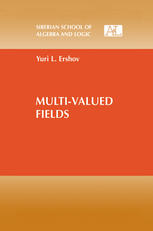

Most ebook files are in PDF format, so you can easily read them using various software such as Foxit Reader or directly on the Google Chrome browser.
Some ebook files are released by publishers in other formats such as .awz, .mobi, .epub, .fb2, etc. You may need to install specific software to read these formats on mobile/PC, such as Calibre.
Please read the tutorial at this link: https://ebookbell.com/faq
We offer FREE conversion to the popular formats you request; however, this may take some time. Therefore, right after payment, please email us, and we will try to provide the service as quickly as possible.
For some exceptional file formats or broken links (if any), please refrain from opening any disputes. Instead, email us first, and we will try to assist within a maximum of 6 hours.
EbookBell Team

4.1
10 reviewsFor more than 30 years, the author has studied the model-theoretic aspects of the theory of valued fields and multi-valued fields. Many of the key results included in this book were obtained by the author whilst preparing the manuscript. Thus the unique overview of the theory, as developed in the book, has been previously unavailable.
The book deals with the theory of valued fields and mutli-valued fields. The theory of Prüfer rings is discussed from the `geometric' point of view. The author shows that by introducing the Zariski topology on families of valuation rings, it is possible to distinguish two important subfamilies of Prüfer rings that correspond to Boolean and near Boolean families of valuation rings. Also, algebraic and model-theoretic properties of multi-valued fields with near Boolean families of valuation rings satisfying the local-global principle are studied. It is important that this principle is elementary, i.e., it can be expressed in the language of predicate calculus. The most important results obtained in the book include a criterion for the elementarity of an embedding of a multi-valued field and a criterion for the elementary equivalence for multi-valued fields from the class defined by the additional natural elementary conditions (absolute unramification, maximality and almost continuity of local elementary properties). The book concludes with a brief chapter discussing the bibliographic references available on the material presented, and a short history of the major developments within the field.